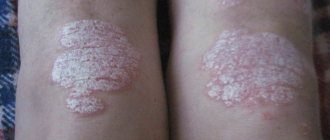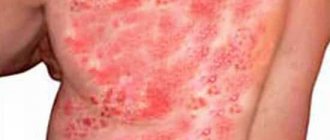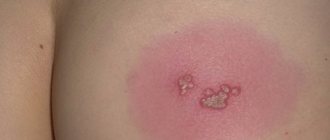Description of herpes
Herpes is a viral disease that can appear in various places on the body. It looks like a small rash of small blisters with liquid inside. Herpes is constantly in an active stage in a huge number of people, and it is not itself that should be feared, but the diseases that it can cause.
Now there are many modern methods and remedies for herpes and its symptoms. Many of them have a cosmetic focus, since the lesions often occur on open areas of the facial skin.
Infectious agents
When a characteristic rash appears on the neck, the cause may be infection with viruses that cause herpes simplex and shingles:
- Herpes simplex virus (HSV types 1 and 2). The manifestation of the first pathogen most often causes a “cold on the lips”, the second – genital herpes. Types 1 and 2 pathogens are the main causes of herpes on the neck.
- Varicella-Zoster virus. Penetrating into the body for the first time, it causes chickenpox (usually in childhood). A secondary manifestation of its activity is herpes zoster. The pathogen spreads along the affected nerves, causing a specific skin reaction.
Activation of these pathogens is the cause of herpes on the neck. Each virus manifests itself differently, so it is important to know the main symptoms of the disease.
Types of herpes
In total, scientists have identified eight types of herpes that can occur in people. Of these, only three are the most common. Quick and effective treatment of herpes at home directly depends on the speed at which the problem is identified and the correct choice of medications. In order to detect the problem quickly, you need to have an idea of what types of herpes there are.
Most often, people experience type 1 herpes - the most common blisters in the lip area. This is often called a lip cold. Doesn't pose any particular danger. The patient is more concerned about the feeling of discomfort and appearance.
The second type of herpes is slightly less common. The source of the lesion is the human genitals. Such herpes is a more serious problem, at least because of the location of its appearance.
The virus moves inside the body without external symptoms, and only when the genitals become infected does a rash appear. Once its activity is extinguished, the virus is sent closer to the most sensitive nerves in the groin area.
It is impossible to completely get rid of the virus - it is in a state of hibernation, and only sometimes appears again for a while. Over time, the periods of time between these bursts become less and less.
Chickenpox is the third type of herpes discussed earlier. It is the causative agent of more serious diseases, such as chickenpox and shingles.
Often remains depressed throughout a person's life.
Types of herpes and what it looks like on the skin
photo of herpes on the skin of the body
Each type of virus causes skin lesions in certain places and has its own clinical symptoms. Types of herpes lesions on the body:
- Labial herpes appears on the skin of the lips, cheeks, on the wings of the nose, in the area of the periungual fold. It can also affect the mucous membrane of the eyes;
- genital herpes is characterized by rashes on the lower extremities, in the anus, buttocks and thighs, affecting the genitals;
- When chickenpox is first infected, it appears as a rash all over the body. With repeated exacerbations, the rash is localized along the intercostal nerves (in a thin or wide strip) with swelling of the skin and severe pain;
- Epstein-Barr virus (or herpes virus type 4) manifests itself as a papular rash over the entire body;
- Roseola infantile appears as a pink rash that covers the face, chest and then spreads to the entire body.
Skin lesions are most often caused by the third type of herpes virus and are accompanied by a vivid clinical picture. It is worth noting that each disease has typical symptoms and atypical manifestations. Therefore, accurate diagnosis of the type of virus will depend not on the clinical picture of the disease, but on special laboratory research methods.
Symptoms of the disease
There are two active stages of common herpes. The first is more harmless and popular. The second is even less pleasant - it is accompanied by pain and the formation of ulcers.
If you have the first stage, then there are many different ways to easily cure herpes in such a situation. At this stage, a rash appears in the lip area. The unpleasant thing to note is a slight burning and itching that occurs in problem areas the day before the rash appears.
Herpes zoster is much more serious. It is accompanied by pain, not only in the area where it appears, but also in the head. There may be migraines. In a neglected state, the bubbles with liquid begin to fester. The area will bleed later if left untreated.
Routes of transmission of genital herpes.
Transmission through saliva has a probability of several percent.
1. During blood transfusion.
Despite the fact that when receiving blood transfusion from a patient with herpes, the risk of infection is close to 100%, this route of transmission is not the leading one, due to the comparative rarity of the procedure and the rather careful selection of donors.
2. Sexual.
This is the most common variant of genital herpes infection. Infection occurs during any type of sex with an infected partner (genital, oral, anal, petting), and the use of a condom helps protect against transmission only in 70-80% of cases. Some researchers do not exclude the possibility of infection from a partner who is in a state where there are no visible symptoms of infection.
When kissing
3. Household.
The genital herpes virus can be transmitted through shared hygiene items (towels, etc.), through bedding and through any tactile contact (handshake, hug). Despite the fact that the predominant route of transmission of this infection is sexual, this type of contact with an infected person is also unsafe.
4. From mother to child.
For example, if a pregnant woman has an active form, the risk of transmission through the placenta is up to 80%. Also, a child can become infected from the mother during childbirth, for example, if the vaginal mucosa is affected by ulcers (vesicles). The third way of infection from mother to child is through an infected mother caring for her children, feeding, etc.
In general, you can get infected from a sick person in different ways. At the same time, it is not at all necessary that he have any visual signs, because many men and women with strong immunity suffer from genital herpes almost asymptomatically, noting only a slight malaise and fever, which can be attributed to an incipient cold.
Since the virus primarily affects people who are sexually active, men aged 18 to 40 are most susceptible to it.
Causes of herpes
Herpes is easily transmitted from the carrier to the future patient. To do this, the first one does not even need to have external signs of the disease - it is transmitted even in a passive state.
The threat is posed not only by personal contact with skin, but also by objects on which skin particles may remain. The same goes for physically damaged areas of skin.
This often happens in underdeveloped countries of the world, where the level of personal hygiene is very low. Herpes of the second type is transmitted through sexual contact.
The virus itself can remain without a carrier for up to one day. We are talking about normal conditions. If the room temperature is above 50 degrees, the virus dies within half an hour.
It can survive in extremely low temperatures for five days. Steel surfaces at normal temperatures can be home to herpes for two hours. This applies to door handles, coins, railings in public places.
Herpes in men and its features
Genital herpes (genital herpes) affects both sexes equally, but if men are infected with this virus, there are a number of features that everyone who cares about their health should be aware of.
Related to sexually transmitted diseases, genital herpes in men is more difficult to tolerate than other types.
The tenderness of the genital tissues causes more pronounced pain and discomfort, and the instruction not to have sex adds psychological inconvenience.
Important : If 90% of the world's population are carriers of the herpes virus, then up to 20% suffer from its genital form. And this figure has been steadily growing over the past half century due to the lifting of many prohibitions in the sphere of sexual relations.
Genital herpes in men
Disease prevention
As you might guess, condoms are the best protection against type 2 herpes. The best, but not absolute. Like a regular virus, it can be transmitted through skin contact, which often occurs during sexual intercourse.
Personal hygiene plays an important role in preventing herpes. Simply washing your hands with soap after visiting a public place significantly reduces the appearance of the virus.
You should not lick your hands in public places. This applies to both children and adults. I have seen so many times how people in the supermarket lick their finger in order to unwrap a simple bag for vegetables or fruits.
What should you be wary of?
The herpes virus, regardless of the type of illness, can lead to very serious problems. Thus, it can negatively affect the reproductive function of both sexes, lead to pathologies in expectant mothers and fetal malformations. With neuroinfection, the mortality rate is 20. More than half of the eyes of people infected with herpes subsequently develop cataracts. If you have HIV infection and herpes, there can be complex consequences, including malignant neoplasms.
Photo of a virus taken using an electron microscope.
As you can see, herpes is a virus that can cause a lot of discomfort and provoke the development of a variety of diseases. Therefore, always be on alert and try to protect yourself as much as possible from the virus with all available means of prevention. Be healthy!
Treatment of herpes
There are many medications that work well during herpes. On the other hand, there are folk remedies and recipes for treating herpes. Both cases have their fans.
It is important to understand that simple tablets that you buy at the pharmacy are a more reliable remedy than your grandmother's prescription. A folk remedy can also help, understand correctly, but it’s up to you to choose.
Frequency and depth of relapses.
You shouldn't feel any discomfort.
Let's run to the doctor! The virus remains in the body after the primary disease, hiding in the nervous tissue for decades in a latent form. Relapses occur in the event of a severe decrease in immunity, which can be caused by hypothermia, overheating, severe stress, etc.
That is, it can have relapses either after a few days or after several years, depending on the state of the body, or it may never appear after the primary disease if the patient’s health remains consistently good.
Important! To treat herpes, our readers successfully use Elena Makarenko’s method. Read more >>>
In case of relapse, skin rashes, blisters and sores can be observed in approximately the same areas as during the initial infection. Moreover, these manifestations pass much faster and are much less accompanied by unpleasant sensations. Skin rashes go away when they recur, usually within a week.
Quite rarely, with relapses of the disease, there is a general deterioration in condition, fever, enlarged lymph nodes in the groin area, and headache. There may be pain when emptying the bladder.
The herpes virus remains in a latent state in the infected person’s body throughout his life, and during periods of exposure to stress factors, it migrates from the nervous tissue, causing recurrent disease.
Photos of herpes treatment
Diagnostic methods
To determine herpes on the neck, the following diagnostic methods are used:
- Dermatological examination. Herpes manifests itself with characteristic symptoms, so in most cases this method makes it possible to make an accurate diagnosis.
- Linked immunosorbent assay. When a herpes virus enters the body, it begins to produce specific antibodies that are easily detected using ELISA. Blood or cerebrospinal fluid is taken for testing.
- PCR. This method is used to determine the DNA of the virus in the sample being tested.
- Culture method. It is used for chronic and latent forms of the disease.










